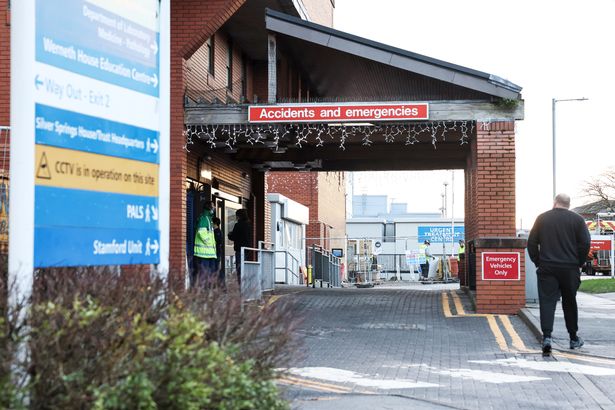“I told him to fight and be strong so he could come home with us”
06:55, 18 Jun 2025Updated 07:02, 18 Jun 2025
 (Image: Men Media)
(Image: Men Media)
A family was left ‘devastated’ after their young son died of septic shock in hospital, an inquest has heard.
Pak Lam Law was just five years old when he tragically passed away at around 10am on December 5th 2023 at Tameside Hospital, Stockport Coroners Court heard today (June 17).
He had been admitted to the hospital the previous afternoon after being transferred there from Salford Royal Infirmary, where he had been diagnosed with pneumonia.
His condition worsened through the night and despite repeated medical intervention he went into cardiac arrest just before 9:30am and died just before 10am after three rounds of CPR.
Senior area coroner Alison Mutch began proceedings by reading a statement from Pak’s mother Li Lai Ma. The parents, who were spoken to via a Cantonese interpreter throughout proceedings, left the room while the distressing account was read out.
“Pak was a healthy, joyful baby who brought immense happiness to the family,” his mother said in her statement.
“He was a cheerful, talkative and intelligent child who loved animals and playing with Spiderman toys.”
“We moved to the UK 12 months before his death and he adapted well. He was all a parent could hope for – thriving and full of life.”
Ms Mutch then read statements from Pak’s GP, the 111 operator who had triaged the family over the phone, the radiologist who had taken an x-ray of Pak at Salford Royal and the NWAS driver who had transferred the family to Tameside, before turning to the facts of the post-mortem.
 (Image: MEN Media)
(Image: MEN Media)
The examination found that Pak had died of multi-organ dysfunction caused by septic shock, itself brought on by invasive pneumococcal pneumonia. There was evidence of fluid in his right lung and in his chest.
Pak had been suffering with stomach pains, vomiting and a high temperature for several days when his parents first brought him to Salford Royal Infirmary on November 30 2023.
That evening doctors diagnosed him with an upper respiratory tract infection and gastroenteritis, and advised Pak’s parents to continue treating him at home with ibuprofen and Calpol.
If he did not improve after five days, the family was told to return to hospital – but Li Lai Ma said that no antibiotics were administered, nor were blood samples taken.
“At that moment I felt that something was not right. My fears and concerns were dismissed,” she alleged.
At home, Pak’s condition did not improve, as he continued to vomit and his appetite ‘disappeared’. The family returned to Salford Royal A&E in the early hours of December 4 with Pak extremely pale and barely managing to drink water.
Upon arrival nurses recorded his blood oxygen, blood pressure and temperature, and an x-ray was ordered. He was periodically reviewed throughout the night.
At 8:30am he was reviewed by Dr Anna Rennie, a consultant in paediatric and emergency medicine at Salford Royal.
In her statement she noted that Pak had no rash and presented normal levels of consciousness, but added that he seemed tired and was ‘working harder than normal’ to breathe on his right-hand side.
Reviewing the x-ray taken overnight, Dr Rennie diagnosed Pak with right-sided pneumonia, and placed him on intravenous antibiotics and a rehydration treatment.
But she explained to the court that, as Salford Royal does not have any paediatric ward beds that can accommodate children for more than 24 hours, Pak was transferred to the nearest available bed which was at Tameside Hospital.
 Tameside Hospital (Image: Manchester Evening News)
Tameside Hospital (Image: Manchester Evening News)
As Pak’s level of risk was assessed as yellow, he did not receive IV treatment during the transfer nor were any medical personnel present – but Dr Rennie deemed that this would be safe for a half-hour journey.
“What was your overall impression of him, looking back?” asked the coroner.
“I did not feel he was septic, but I was concerned about his risk of deterioration, and that includes sepsis,” Dr Rennie replied. “Any child with pneumonia is at risk of that.”
She added that a ‘full set’ of notes was sent over with every transferred patient and that a verbal ‘clinician to clinician’ conversation took place in which she informed staff at Tameside hospital of Pak’s history and any concerns she had.
“It was expressly mentioned that I felt concerned about him,” she continued. “any clinician with sufficient training will recognise that a child with pneumonia is at risk of sepsis.”
“What was the name of the person you spoke to?” the coroner asked.
“Unfortunately I didn’t get their name,” Dr Rennie answered. “That is something I have reflected on following this case.”
The family were then transferred to Tameside Hospital, arriving at around 2pm on December 4. Registered paediatric nurse and ward manager Holly Martin, who did not come into contact with Pak until her shift began on the morning of December 5, detailed in her report how nurses had taken observations of Pak’s progress throughout the night.
The court heard how he continued to receive antibiotics and hydrating fluids via an IV, but his condition continued to worsen.
His heart and breathing rate continued to climb, while he remained by turns drowsy and agitated, not responding to light shone in his eyes.
Coroner Mutch asked Ms Martin about the observations the nurses took, which are used to calculate the PEWS score, a paediatric early warning system used to monitor deterioration in patients.
Ms Martin agreed that some of the notes were incomplete. “How do you create a PEWS score when some observations, such as blood pressure, are not recorded?” the coroner asked.
“The old scoring system did not require all these elements in order to create a score,” Ms Martin replied. “We have since moved to a different system.”
There was also discussion of the ‘sepsis bundle’, a set of treatments and checks designed to reduce sepsis mortality.
“Was the bundle used in Pak’s case? ” the coroner asked. “I do not believe so, based on the notes,” came the reply.
“Should it not have been, when his PEWS score went from 2 to 5 between 2:30 and 4am? The doctor notes suggest that around 4:30am there was a clinical review from the registrar – is that what the nursing notes suggest?” Ms Mutch continued.
“They show that there was further medical review but it’s not clear at what time. It’s not in the documents,” Ms Martin replied.
Counsel for the family Louise Green focused on the frequency of the nurses’ observations. “Do you agree that it looks like no nursing observations took place between 8pm and 12:30am?” she asked Ms Martin.
“That is what the documents would appear to show,” she replied.
 Stockport Coroner’s Court(Image: Gary Oakley/Manchester Evening News)
Stockport Coroner’s Court(Image: Gary Oakley/Manchester Evening News)
At around 6:30am on December 5 Pak was moved to the high-care bed in the paediatric unit. NWTS (North West Paediatric Transport Service) and the on-call paediatric consultant, Dr Mazen Haider, were called in.
Dr Haider had began his shift at 5pm on December 4 and went home at 8pm, remaining on-call overnight until 9am the following day.
Overnight he had discussed Pak with the hospital registrar, who told him he had become less responsive and was now vomiting a dark brown substance.
“What was it that caused you to recognise that Pak was in septic shock?” the coroner asked.
“The repeated administering of fluids and the repeated tachycardia (heart rate over 100bpm),” he replied. “The registrar had taken several steps to manage his condition.”
Dr Haider stressed that, when he arrived for his shift the previous evening, none of Pak’s observations were consistent with sepsis. “Before I left I asked the staff if they had concerns about anyone – and no-one did at that time.”
His notes clarified that Pak was treated throughout the night but it did not appear to be having an effect, though there was no significant deterioration until around 5:30am.
“You did not get the phone call until 45 minutes later though,” said the coroner. “At that point it was quite clear that it was septic shock – it is now a race against the clock, is it not?” “Yes,” Dr Haider agreed.
But he also spoke of the difficulty in diagnosing sepsis. “Discoloured vomit could be stress,” he said. “And any child who has vomited will be looking pale.”
“Pneumonia is common but the sepsis progression is rare, and progression into septic shock even rarer,” he added.
Dr Haidar arrived at the hospital at around 7:15 am when Pak was given an oxygen mask to help him breathe. He was intubated and given adrenaline but he entered cardiac arrest.
In her statement read out at the start of proceedings, Pak’s mother Li Lai Ma said she “strongly felt there were missed opportunities” for staff to help Pak and “possibly save his life.”
“When he was given an oxygen mask, he was clearly distressed and weak, but was trying to speak and say something,” she said.
“I will never forget the image of him struggling to speak while they covered his mouth again and again. That moment is burned into my mind.”
“I told him to fight and be strong so he could come home with us. After the final cardiac arrest I started shouting at them to keep going but the doctor said he was gone.
“We were both just devastated. We all said goodbye and just held each other. Our healthy, happy child, it felt impossible to understand.”
“My son was misdiagnosed and critical opportunities to save his life were missed. I strongly believe that had a consultant been informed earlier, his death could have been prevented.
“It was a serious infection but they did not escalate his care and did not listen when I told them something was wrong.
“All I want is for the real reason for his death to be known and for the court to look into the treatment from the staff involved. They did not take their responsibility seriously enough.”
Like the other witnesses, Dr Haider offered his ‘deepest condolences’ to the family at the end of his statement. “I want them to know that we did all we could to save him,” he said.
The inquest continues.
